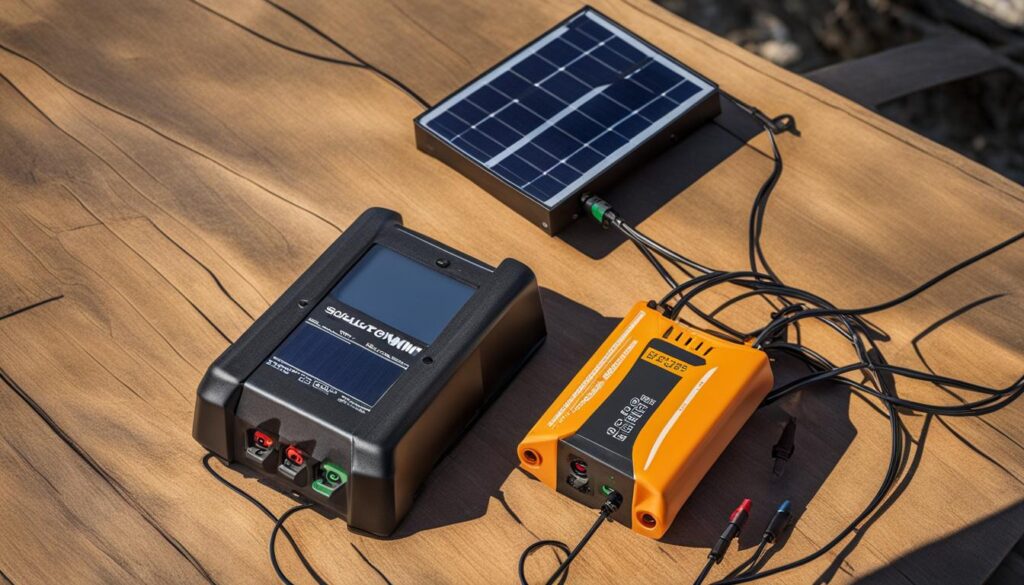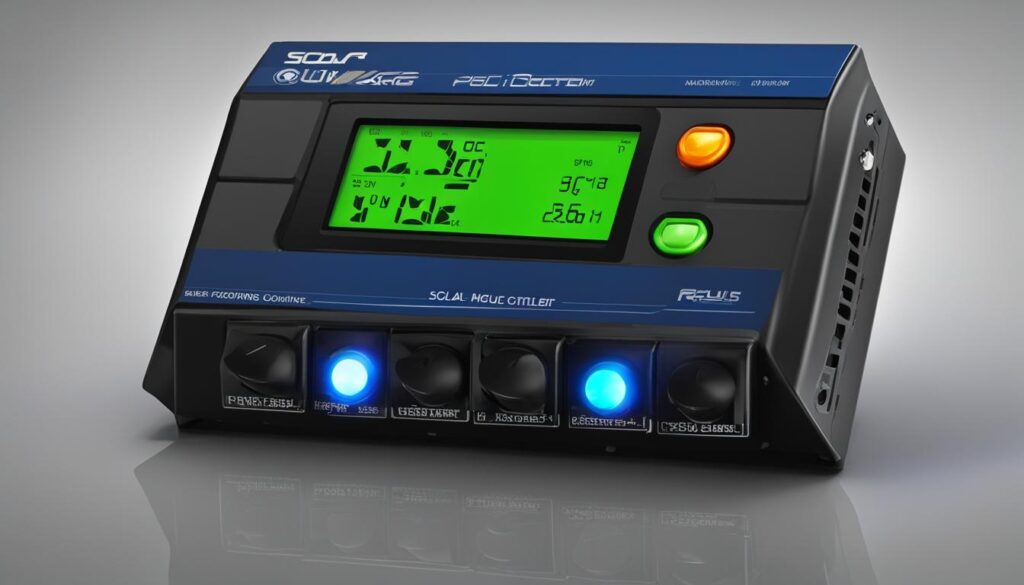A PWM solar charge controller is a vital component in managing solar energy systems. It plays a crucial role in regulating the voltage to match the load’s requirements, optimizing battery charging, and maintaining battery health. While these controllers may not be as popular as they once were, they still offer several benefits and have their place in solar energy management.
Key Takeaways:
- 1. PWM solar charge controllers regulate the voltage of the solar power system to match the load’s requirements.
- 2. These controllers optimize battery charging and help maintain battery health.
- 3. PWM solar controller have their advantages and limitations in solar energy management.
- 4. They are suitable for smaller solar systems.
- 5. PWM charge controllers were commonly used in the 90s but have been replaced by modern MPPT solar charge controller.
Introductory Guide to PWM Solar Charge Controllers

When it comes to solar energy management, one of the key devices used is the PWM solar charge controller. While it may not be as mainstream as it once was, the PWM controller still holds relevance in the industry. In this section, we will explore the origins of PWM technology, demystify the PWM algorithm and its functionality, and discuss the significance of PWM in solar energy management.
Origins and Modern Relevance of PWM Technology
PWM technology first gained popularity in the 1990s as a method for regulating voltage in various applications. Although it has been around for decades, PWM still finds its place in the world of solar energy management. This technology offers a cost-efficient solution for optimizing battery performance and maintaining battery health.
Demystifying the PWM Algorithm and Its Functionality
The PWM algorithm plays a crucial role in the operation of a solar charge controller. It is responsible for regulating the voltage of the solar power system to match the voltage requirements of the load. By modifying the input waveform, the PWM controller creates a specific waveform necessary for efficient charging and powering of the connected devices. This algorithm helps maximize the use of solar energy and extends the lifespan of the battery.
The Significance of PWM in Solar Energy Management
PWM technology holds great significance in the field of solar energy management. By actively regulating voltage, the PWM charge controller ensures that the solar power system operates within the optimal voltage range, preventing overcharging or undercharging of the battery. Additionally, PWM controllers help protect the battery by preventing overheating, gassing, and other voltage-related issues. These controllers are a reliable and cost-effective solution for smaller solar systems, making them an integral part of solar energy management.
| Key Points | Details |
|---|---|
| PWM Technology | First gained popularity in the 1990s |
| PWM Algorithm | Regulates voltage to match load requirements |
| Benefits | Maximizes use of solar energy, extends battery lifespan, prevents overheating and gassing |
| Applicability | Suitable for smaller solar systems |
How PWM Charge Controllers Optimize Battery Charging
PWM charge controllers play a crucial role in optimizing battery charging for solar power systems. These controllers employ a three-stage charging process to ensure efficient and effective energy management.
The Three-Stage Charging Process Explained
The three-stage charging process consists of bulk charging, absorption charging, and float charging.
In the first stage, known as bulk charging, the PWM charge controller delivers a high current to rapidly charge the battery. This stage allows the battery to charge quickly and reach a suitable voltage level.
Once the battery voltage reaches a predetermined threshold, the controller switches to the second stage, absorption charging. During this phase, the controller maintains a constant voltage level, allowing the battery to absorb the remaining charge gradually. This stage ensures that the battery charges fully without overcharging, which could lead to damage.
After the absorption charging stage, the controller enters the final stage, known as float charging. In this stage, the controller reduces the charging voltage to a lower level, just enough to compensate for any self-discharge the battery may experience. Float charging helps maintain the battery’s full charge capacity without overcharging or causing any damage.
Maintaining Battery Health with PWM Controllers
PWM charge controllers are designed to safeguard battery health by preventing issues such as overheating and gassing. These controllers regulate the charging process to ensure that the battery remains within safe temperature limits and avoids excessive gas generation.
Overheating can reduce battery lifespan and performance, while excessive gas accumulation can lead to pressure build-up and potential damage. By controlling the charging process, PWM controllers help maintain the battery’s optimal health and extend its overall lifespan.
Understanding the Technical Nuances: Frequency Modulation
Frequency modulation is a vital technical aspect of PWM charge controllers. It involves adjusting the frequency levels to calibrate the output waveform. By varying the frequency, PWM controllers can precisely control the voltage waveform to match the requirements of the load and optimize battery charging.
Frequency modulation allows for finer adjustment of the charging process, ensuring that the battery receives the appropriate amount of charge while minimizing the risk of overcharging or undercharging. This feature enhances the overall efficiency and effectiveness of PWM charge controllers in managing solar energy systems.

Features and Benefits of Using a PWM Solar Charge Controller
A PWM solar charge controller provides several features and benefits that make it a reliable option for managing solar energy. Let’s take a closer look at what sets it apart:
1. Higher Battery Capacity Reserve: PWM solar charge controllers offer a higher battery capacity reserve compared to on-off regulated charge controllers. With a typical reserve of 90-95%, they provide better power storage, ensuring that your batteries have enough energy to meet your needs even during low sunlight conditions.
2. Overheating Prevention: These controllers are designed to prevent battery and load overheating. By regulating the voltage and current, they help maintain optimal temperature levels, reducing the risk of damage to your solar panels and batteries.
3. Voltage Stability: PWM controllers effectively control the voltage rises and mitigate the negative effects of high temperatures. This ensures a stable and consistent flow of electricity, protecting your devices and appliances from potential damage caused by voltage fluctuations.
4. Suitable for Smaller Solar Systems: If you have a smaller solar system, a PWM solar charge controller is an ideal choice. They are designed to meet the needs of smaller setups, such as residential solar installations or small-scale off-grid systems. Their compact size and affordable pricing make them accessible to a wider range of consumers.
By leveraging these features and benefits, a PWM solar charge controller can significantly improve the efficiency and performance of your solar power system, making it a valuable investment for both residential and commercial applications.
| Features | Benefits |
|---|---|
| Higher Battery Capacity Reserve | Ensures sufficient energy storage, especially during low sunlight conditions |
| Overheating Prevention | Protects solar panels and batteries from damage caused by overheating |
| Voltage Stability | Ensures a stable and consistent flow of electricity |
| Suitable for Smaller Solar Systems | Ideal for residential installations and small-scale off-grid systems |
Conclusion
An Overview of PWM Charge Controller Performance and Cost
PWM charge controllers have a long-standing history of reliable performance and affordability. In the 90s, these controllers were widely used and had a price range of INR 1500 to 2000. They played a crucial role in managing solar energy and optimizing battery charging in smaller solar systems.
Comparing the PWM with Modern MPPT Solar Charge Controllers
However, with advancements in technology, modern MPPT solar charge controllers have emerged as a more efficient and popular alternative to PWM controllers. MPPT controllers offer higher productivity and have a larger market presence. They utilize the latest tracking algorithms to maximize the energy harvested from solar panels and deliver it to the batteries.
When comparing PWM and MPPT controllers, there are notable differences to consider. MPPT controllers have significantly higher productivity, making them more suitable for larger solar systems. They also have a wider range of available sizes, ensuring compatibility with various installations. As a result of their increased capabilities, MPPT controllers generally come with a higher price point compared to PWM controllers.
While PWM charge controllers still have their benefits and are suitable for smaller solar systems, the industry has largely transitioned to MPPT controllers. The choice between PWM and MPPT ultimately depends on the specific requirements and budget of the solar installation.
FAQ
What is a PWM solar charge controller?
A PWM solar charge controller is a device used in solar energy management that regulates the voltage of the solar power system to match the voltage of the load.
How does a PWM solar charge controller work?
PWM solar charge controllers modify the input waveform to create a specific kind of waveform required for the output. They optimize battery charging and help maintain battery health.
What is the three-stage charging process in PWM charge controllers?
The three-stage charging process in PWM charge controllers consists of bulk charging, absorption charging, and float charging. This process helps optimize battery performance and prevent overheating and gassing.
What is frequency modulation in PWM charge controllers?
Frequency modulation is a technical aspect of PWM charge controllers that involves adjusting the frequency levels to calibrate the output waveform.
What are the benefits of using a PWM solar charge controller?
PWM solar charge controllers offer higher battery capacity reserve, prevent overheating and voltage rises, and are suitable for smaller solar systems.
How do PWM solar charge controllers compare to MPPT controllers?
PWM solar charge controllers have been replaced by modern MPPT controllers that offer higher productivity and larger market presence.

